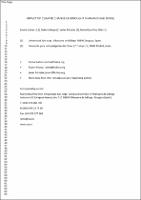Por favor, use este identificador para citar o enlazar este ítem:
https://repositorio.usj.es/handle/123456789/1093
| Título : | Impact of climate change on drought in Aragon (NE Spain) (Versión aceptada) |
| Autor: | Gaitán Fernández, Emma

Monjo, Robert 

Pórtoles, Javier 
Pino Otín, Rosa 

|
| Palabras clave : | Climatic change; Drought; Aragon |
| Fecha de publicación: | 10-jun-2020 |
| Editorial : | Elsevier |
| Citación : | Emma Gaitán; Robert Monjo; Javier Portoles; Mª Rosa Pino-Otín. Impact of climate change on drought in Aragon (NE Spain). Science of the Total Environment (STOTEN). 740:140094. Elsevier, https://doi.org/10.1016/j.scitotenv.2020.140094 |
| Resumen : | Droughts are one of the extreme climatic phenomena with the greatest and most persistent impact on health, economic activities and ecosystems and are poorly understood due to their complexity. The exacerbation of global warming throughout this century probably will cause an increase in droughts, so accurate studies of future projections at a local level, not done so far, are essential. Climate change scenarios of drought indexes for the region of Aragon (Spain) based on nine Earth System Models (ESMs) and two Representative Concentration Pathways (RCPs) corresponding to the fifth phase of the Coupled Model Intercomparison Project (CMIP5) have been generated for the first time. Meteorological Drought episodes were analysed from three main aspects: magnitude (index values), duration and spatial extent. The evolution of drought is also represented in a novel way, allowing identification, simultaneously, of the intensity of the episodes as well as their duration in different periods of accumulation and, for the first time, at the observatory level. Future meteorological drought scenarios based on the Standardized Precipitation Index (SPI) hardly show variations in water balance with respect to normal values. However, the Standardized Precipitation Evapotranspiration Index (SPEI) which, in addition to precipitation, considers evapotranspiration, shows a clear trend towards increasingly intense periods of drought, especially when considering cumulative periods and those at the end of the century. Representation of the territory of the drought indexes reflects that the most populated areas (Ebro Valley and SW of the region), will suffer the longest and most intense drought episodes. These results are key in the development of specific measures for adapting to climate change. |
| URI : | https://repositorio.usj.es/handle/123456789/1093 |
| ISSN : | 1879-1026 |
| Aparece en las colecciones: | Artículos de revistas |
Ficheros en este ítem:
| Fichero | Descripción | Tamaño | Formato | |
|---|---|---|---|---|
| Impact of climate change.pdf | 3,55 MB | Adobe PDF |  Visualizar/Abrir |
Este ítem está sujeto a una licencia Creative Commons Licencia Creative Commons

